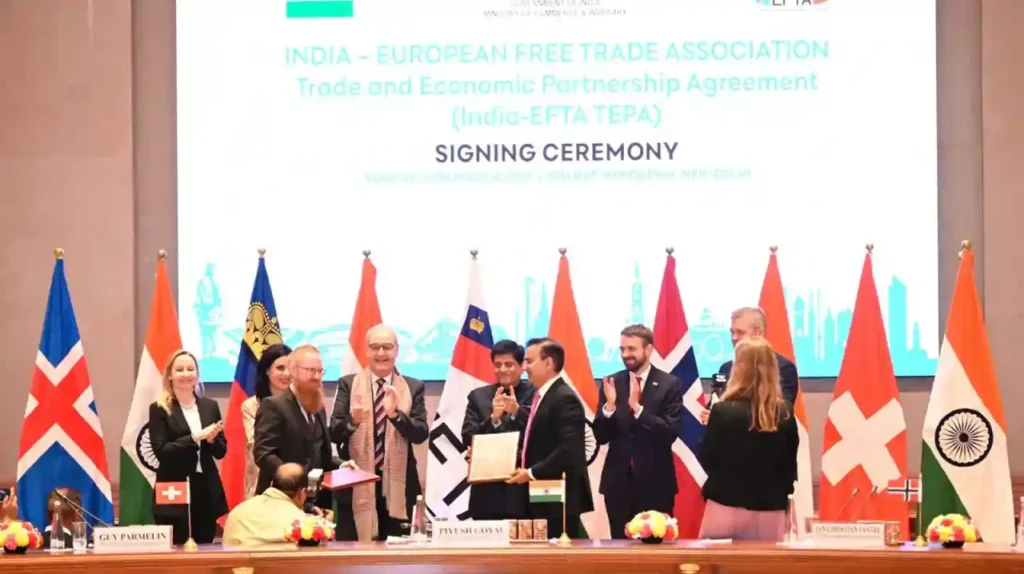New Delhi: In a landmark move for India’s global trade strategy, the India-European Free Trade Association (EFTA) Trade and Economic Partnership Agreement (TEPA) is slated to take effect on October 1, 2025, as announced by Union Commerce and Industry Minister Piyush Goyal on July 19, 2025, in Mumbai. Signed on March 10, 2024, this historic free trade agreement (FTA) between India and the four-nation EFTA bloc—comprising Iceland, Liechtenstein, Norway, and Switzerland—promises to unlock significant economic opportunities, including a binding commitment of $100 billion in foreign direct investment (FDI) and the creation of 1 million direct jobs in India over the next 15 years.

What is the India-EFTA TEPA?
The India-EFTA TEPA is a robust free trade agreement designed to foster economic cooperation, enhance market access, and promote investment between India and the EFTA bloc. Signed after nearly 16 years of negotiations, which began in January 2008 and were revived in 2023 after a period of dormancy, TEPA addresses critical aspects of trade, including market access for goods and services, rules of origin, trade facilitation, trade remedies, sanitary and phytosanitary measures, intellectual property rights (IPR), and trade and sustainable development. The agreement also includes provisions for mutual recognition agreements (MRAs) in professional services, such as nursing, chartered accountancy, and architecture, enabling Indian professionals to work in EFTA countries.
A standout feature of TEPA is its unprecedented binding commitment from EFTA nations to invest $100 billion in India over 15 years—$50 billion within the first 10 years of implementation and an additional $50 billion in the subsequent five years. This investment is expected to generate 1 million direct jobs in India, marking the first time an Indian FTA has included such a legally binding pledge. In return, India has agreed to provide lower or zero duties on select EFTA products, such as Swiss watches, chocolates, biscuits, clocks, and cut and polished diamonds, while safeguarding sensitive domestic sectors like dairy, soya, coal, and certain agricultural products by keeping them on an exclusion list.
Key Provisions of the India-EFTA TEPA
Market Access and Tariff Reductions
TEPA significantly enhances market access for both India and EFTA nations. EFTA has offered 92.2% of its tariff lines, covering 99.6% of India’s exports, including 100% of non-agricultural products and tariff concessions on processed agricultural products (PAP). This opens premium European markets for Indian exporters, particularly in sectors like chemicals, iron and steel, gold, precious stones, yarns, sports goods, glassware, and bulk drugs. Notably, both basmati and non-basmati rice from India will benefit from duty concessions in EFTA countries without reciprocity, boosting India’s agricultural exports.
India, in turn, is offering 82.7% of its tariff lines, covering 95.3% of EFTA exports, of which over 80% are gold imports. The effective duty on gold remains unchanged to protect India’s domestic market. India will phase out customs duties on high-quality Swiss products like watches, chocolates, and biscuits over a 10-year period, making these premium goods more affordable for Indian consumers. However, wines priced below $5 are excluded from duty concessions to safeguard local wine manufacturers. Sensitive sectors, including pharmaceuticals, medical devices, and processed foods under India’s Production Linked Incentive (PLI) scheme, have been carefully protected during negotiations.
Investment and Job Creation
The $100 billion FDI commitment is a cornerstone of TEPA, aimed at bolstering India’s growing sectors, such as digital trade, banking, financial services, transport, logistics, industrial machinery, biotechnology, pharmaceuticals, chemicals, food processing, and clean energy. The agreement excludes foreign portfolio investments and sovereign wealth funds but includes investments by EFTA entities routed through other countries. To ensure accountability, India retains the right to withdraw tariff concessions if EFTA fails to meet its investment obligations, reinforcing the legally binding nature of the commitment.
The anticipated 1 million direct jobs will span various industries, aligning with India’s vision of Viksit Bharat—a developed India by 2047. The creation of a Dedicated India-EFTA Desk will serve as a single-window platform to facilitate trade, investment, and business partnerships, easing entry for EFTA-based investors into India’s booming economy.
Services Sector Opportunities
TEPA opens significant opportunities in the services sector, with India offering 105 sub-sectors, including accounting, business services, computer services, distribution, and health. EFTA nations have reciprocated with commitments in 128 sub-sectors from Switzerland, 114 from Norway, 107 from Liechtenstein, and 110 from Iceland. Indian services exports, particularly in legal, audio-visual, research and development (R&D), computer, accounting, and auditing services, are expected to receive a significant boost. Additionally, the agreement facilitates Indian companies’ integration into European Union (EU) markets, as over 40% of Switzerland’s global services exports are directed to the EU. Indian firms can leverage Switzerland as a base to expand their market reach in Europe.
Intellectual Property and Professional Services
The agreement addresses India’s concerns regarding intellectual property rights, particularly in the pharmaceutical sector, by safeguarding generic medicines and preventing the evergreening of patents. The inclusion of MRAs for professional services like nursing, chartered accountancy, and architecture will enable Indian professionals to access opportunities in EFTA countries, fostering greater mobility and collaboration.
India-EFTA Trade Relations
In 2024–25, India-EFTA bilateral trade reached $24.4 billion, with Switzerland being India’s largest trading partner within the bloc, followed by Norway. India faces a significant trade deficit, largely due to gold imports from Switzerland, which accounted for $20.7 billion in 2021–22. Other key imports from EFTA nations include silver, coal, pharmaceuticals, vegetable oil, dairy machinery, medical items, crude, and scientific equipment. TEPA aims to address this trade imbalance by boosting India’s exports and attracting substantial FDI to diversify trade flows.
About the European Free Trade Association (EFTA)
Founded in 1960 under the Stockholm Convention, EFTA is an intergovernmental organization dedicated to promoting free trade and economic integration among its four member states: Switzerland, Iceland, Norway, and Liechtenstein. Unlike the European Union, EFTA operates as a distinct trade bloc, focusing on liberalizing trade and fostering economic cooperation. Initially established with seven founding members—Austria, Denmark, Great Britain, Norway, Portugal, Sweden, and Switzerland—EFTA has evolved into a key player in global trade, with Switzerland as its economic powerhouse.
Strategic Importance of TEPA
Speaking at the Assocham First Managing Committee Meeting FY2025-26 in Mumbai on July 19, 2025, Minister Piyush Goyal emphasized that TEPA aligns with India’s broader trade strategy, which prioritizes national interest. “Our negotiations strategy hinges on national interest. At no point of time will the Narendra Modi government ever allow national interest to be compromised,” Goyal stated. He highlighted India’s growing global influence, noting that “the world is recognising India’s strength today, and the talent and skill are in India,” which provides significant negotiation leverage.
Goyal also underscored the importance of resilient supply chains, referencing lessons from the COVID-19 pandemic and recent export bans on permanent magnets and fertilizers. “Countries that do not take care of their supply chains and ensure that supply chains are resilient will suffer,” he warned, advocating for the development of domestic industries to replace imports with high-quality, scalable production.
The minister called for a mindset shift within India’s Micro, Small, and Medium Enterprises (MSME) sector, urging collective growth and mutual support between small and large firms. He encouraged MSME stakeholders to report non-tariff barriers to the government and emphasized the importance of research, innovation, quality, and scaling up to compete globally. Goyal’s appeal to “be vocal for local” reflects India’s push for self-reliance while integrating into global value chains.
Economic Impact and Future Prospects
TEPA is expected to unlock massive FDI and deepen trade and economic cooperation across sectors like pharmaceuticals, fintech, agritech, and clean energy. The agreement’s success hinges on India maintaining an average GDP growth rate of 9.5% in USD terms, aligning with its historical growth trajectory. By fostering investment and job creation, TEPA will strengthen India’s position as one of the world’s fastest-growing major economies and enhance EFTA’s footprint in South Asia amid global trade realignments.
For Indian consumers, the agreement promises access to premium Swiss products at lower prices, while Indian exporters gain entry into high-value European markets. The deal also positions India as a hub for innovation and investment, with EFTA’s commitment to sectors like digital trade, biotechnology, and clean energy aligning with India’s growth priorities.
Implementation and Next Steps
All four EFTA countries have ratified the agreement and submitted their documents to the repository in Norway, paving the way for TEPA’s implementation on October 1, 2025. The Dedicated India-EFTA Desk will play a pivotal role in ensuring smooth execution, acting as a bridge between governments and private companies. As India and EFTA prepare to roll out this transformative pact, the focus will be on leveraging its provisions to drive economic growth, create jobs, and strengthen bilateral ties.
In conclusion, the India-EFTA TEPA marks a significant milestone in India’s trade and economic strategy, offering a blueprint for mutually beneficial partnerships with developed economies. By balancing market access, investment commitments, and national interests, TEPA sets the stage for a new era of economic cooperation, positioning India as a global trade powerhouse by 2047.
FAQs
1. What is the India-EFTA TEPA, and when will it take effect?
The India-EFTA Trade and Economic Partnership Agreement (TEPA) is a free trade agreement signed on March 10, 2024, between India and the European Free Trade Association (EFTA), which includes Iceland, Liechtenstein, Norway, and Switzerland. It aims to enhance trade, investment, and economic cooperation by providing market access, reducing tariffs, and fostering job creation. The agreement is set to take effect on October 1, 2025, as announced by Union Commerce and Industry Minister Piyush Goyal.
2. What are the key benefits of TEPA for India?
TEPA includes a binding commitment from EFTA nations to invest $100 billion in India over 15 years ($50 billion in the first 10 years and $50 billion in the next five), creating 1 million direct jobs. India will gain access to premium European markets for its exports, with EFTA offering 99.6% tariff coverage on India’s exports, including 100% of non-agricultural products. Indian consumers will benefit from lower prices on Swiss products like watches, chocolates, and biscuits due to phased-out customs duties. The agreement also boosts India’s services sector, including IT, legal, and audio-visual services, and facilitates integration into EU markets.
3. How does TEPA impact EFTA countries?
EFTA nations gain access to India, one of the world’s fastest-growing major economies, strengthening their presence in South Asia. India is offering 82.7% of its tariff lines, covering 95.3% of EFTA exports, including high-value products like Swiss watches and chocolates. The agreement provides EFTA investors opportunities in India’s growing sectors, such as digital trade, biotechnology, pharmaceuticals, and clean energy, while fostering trade and economic integration.
4. Which sectors are protected under TEPA, and what are the exclusions?
India has safeguarded sensitive sectors by keeping dairy, soya, coal, and certain agricultural products on an exclusion list. The effective duty on gold imports, which constitute over 80% of India’s imports from EFTA, remains unchanged. Wines priced below $5 are excluded from duty concessions to protect local manufacturers. India’s interests in generic medicines and concerns about patent evergreening in pharmaceuticals are also addressed, ensuring protection for domestic industries.
5. How will TEPA be implemented, and what measures ensure its success?
All four EFTA countries have ratified TEPA and submitted their documents to the repository in Norway, enabling its implementation from October 1, 2025. A Dedicated India-EFTA Desk has been launched to act as a single-window platform for governments and private companies, facilitating trade and investment. India can withdraw tariff concessions if EFTA fails to meet its $100 billion investment commitment, ensuring accountability. The agreement’s success depends on India maintaining a 9.5% GDP growth rate in USD terms, aligning with its historical trends.

